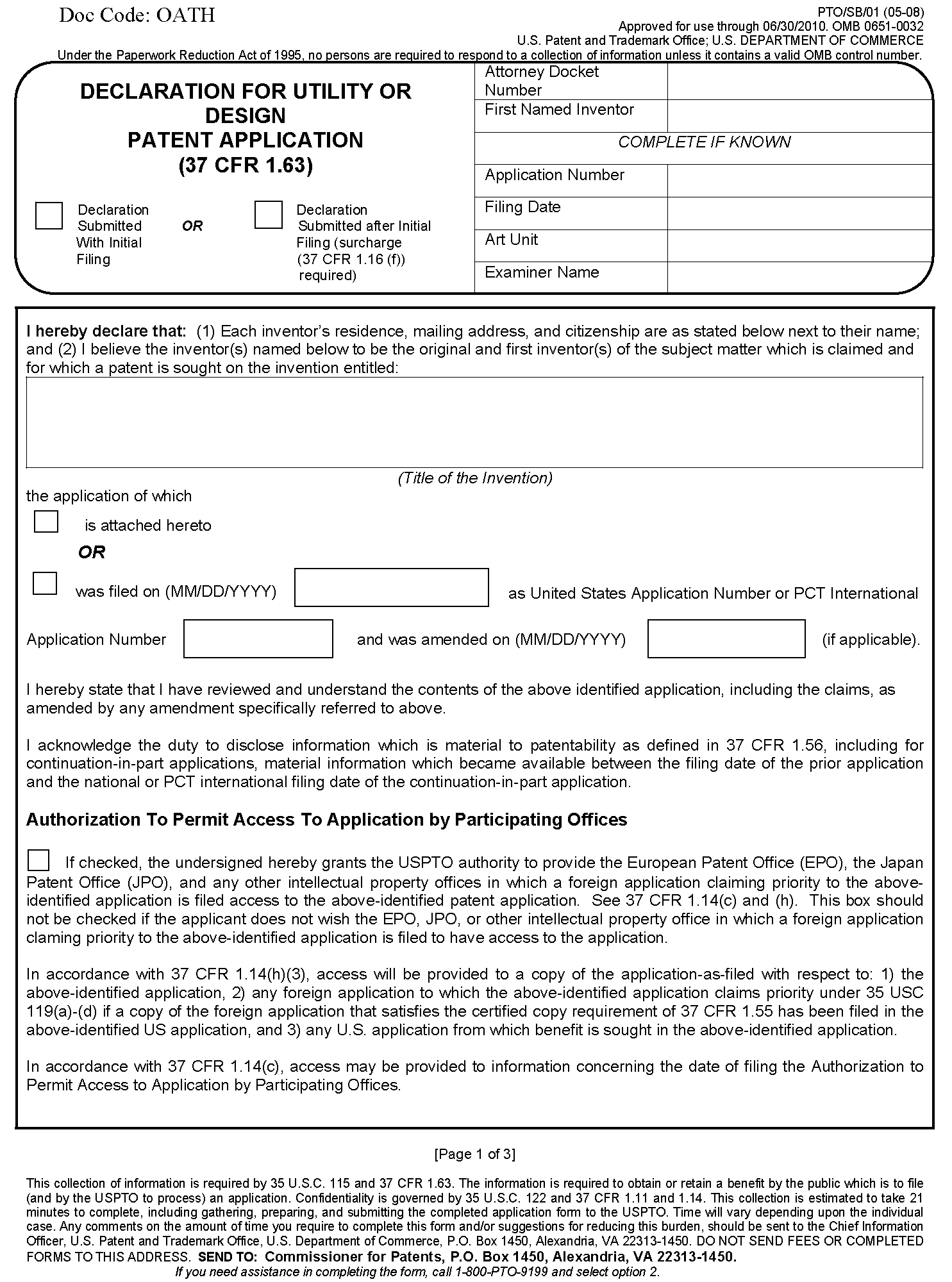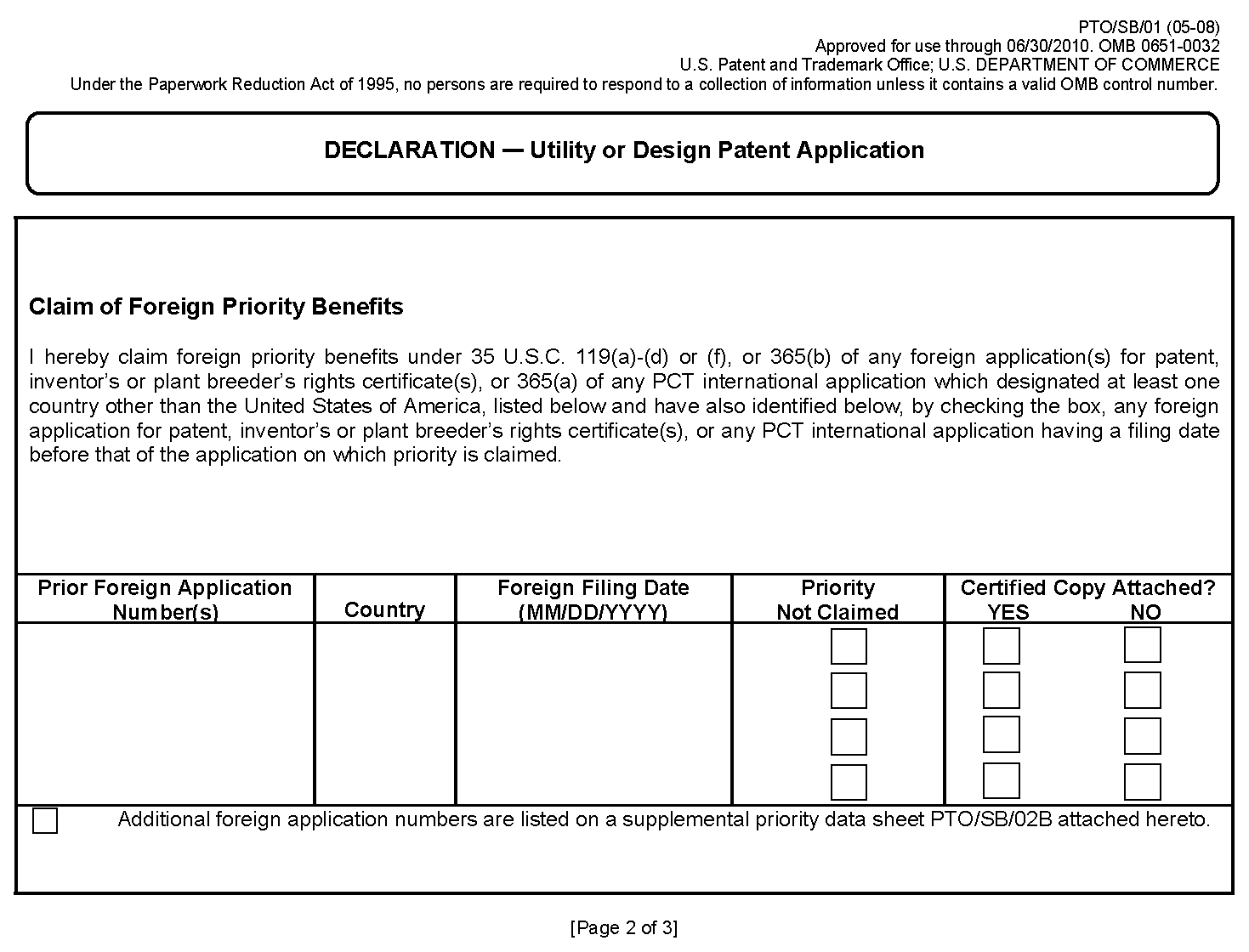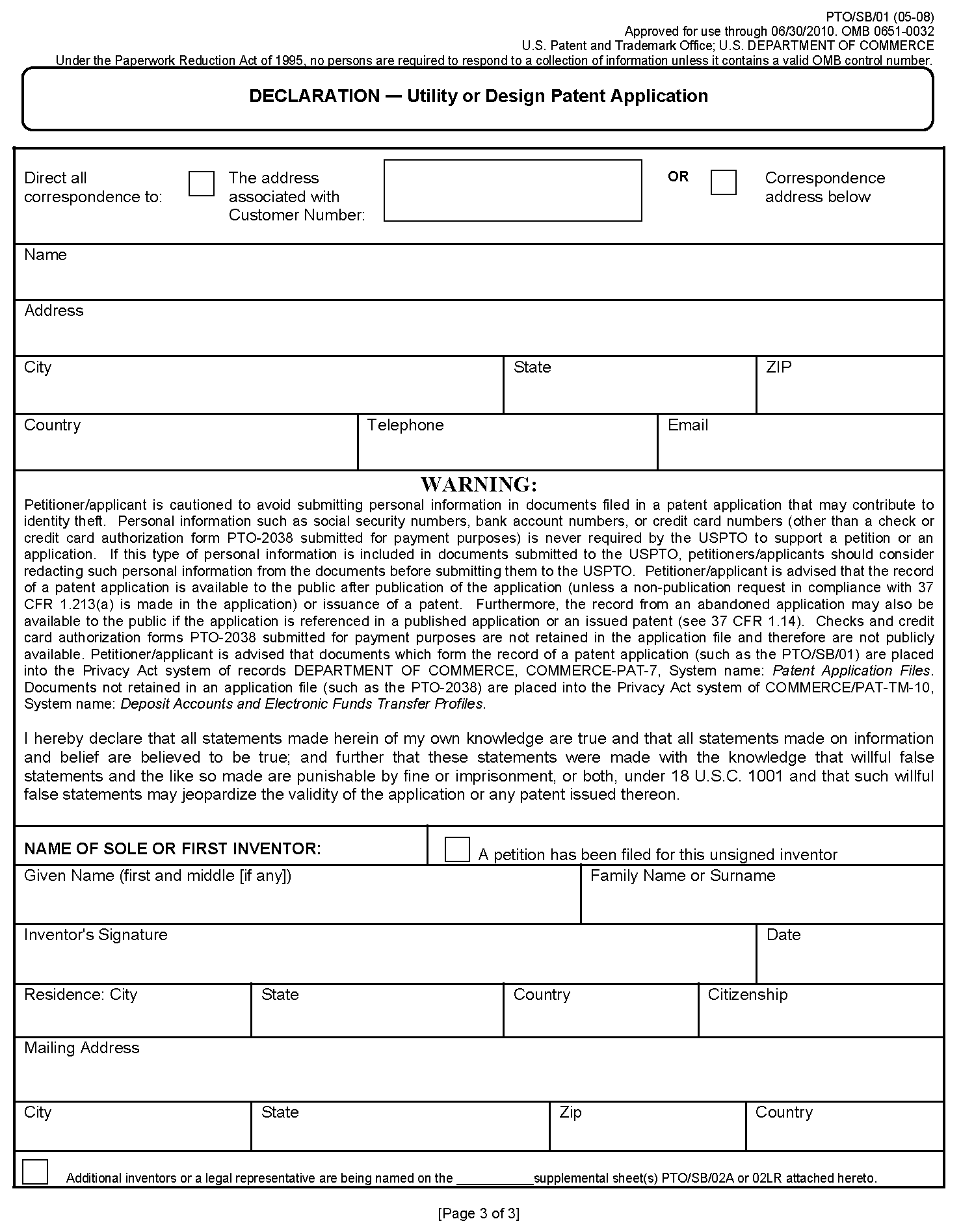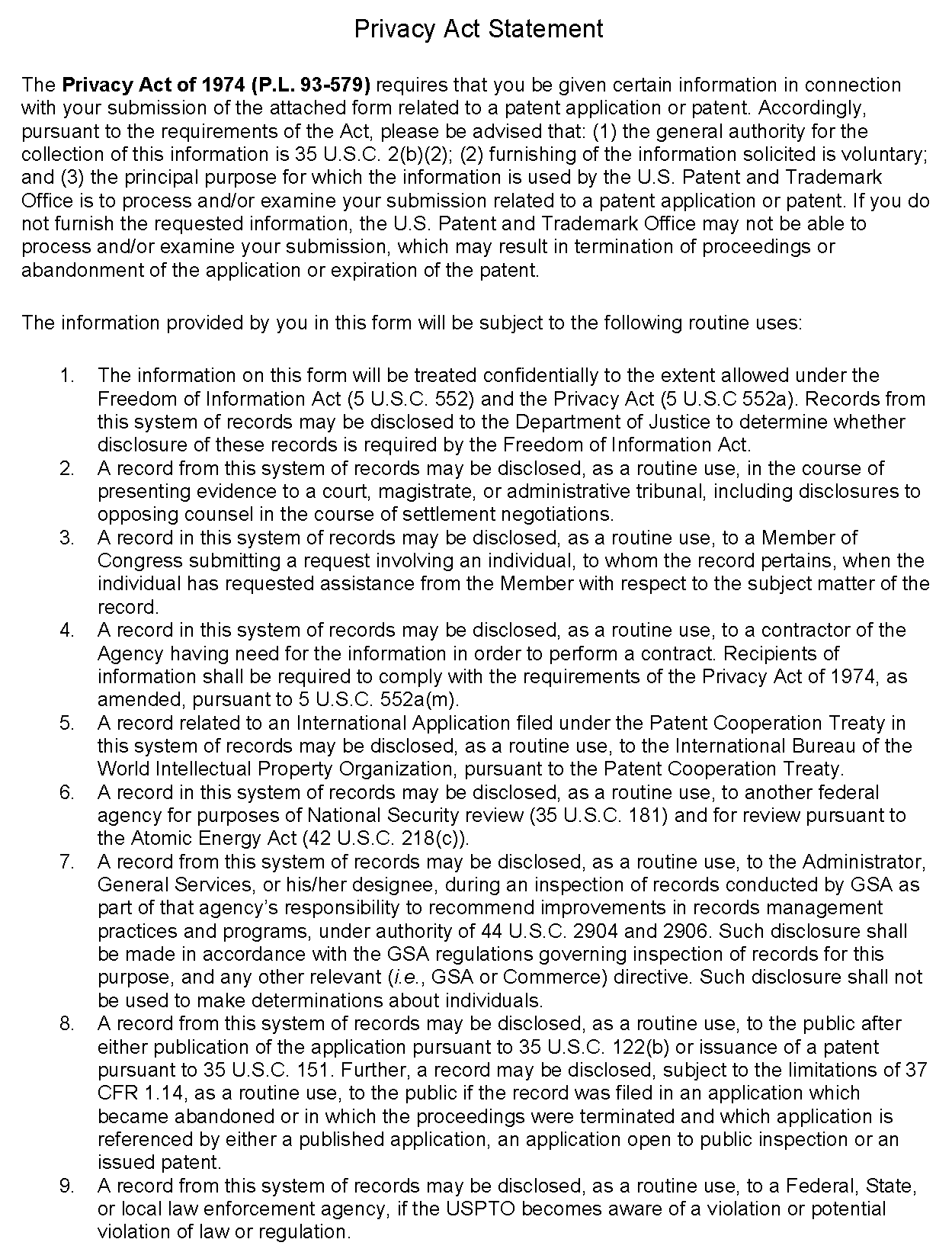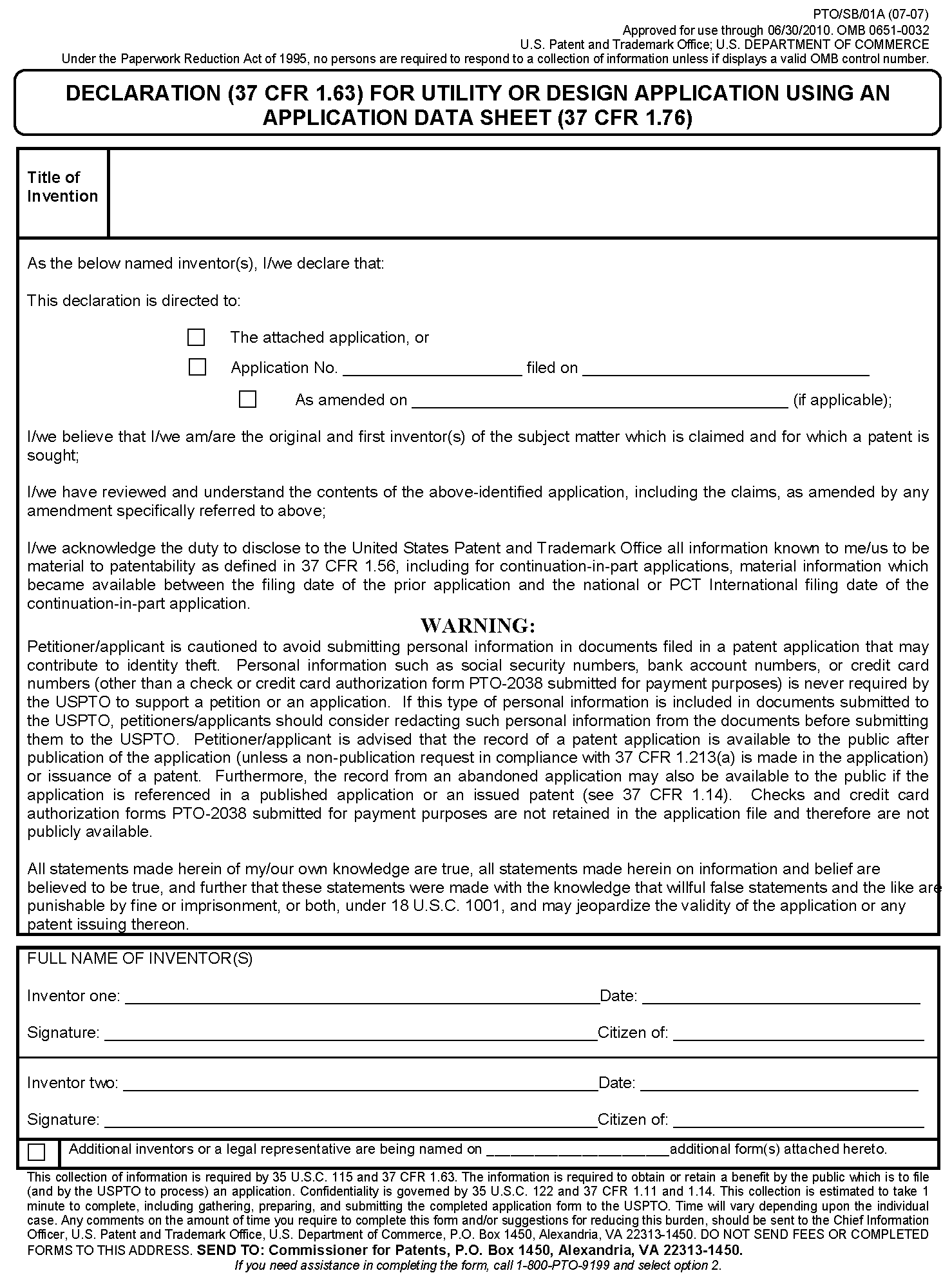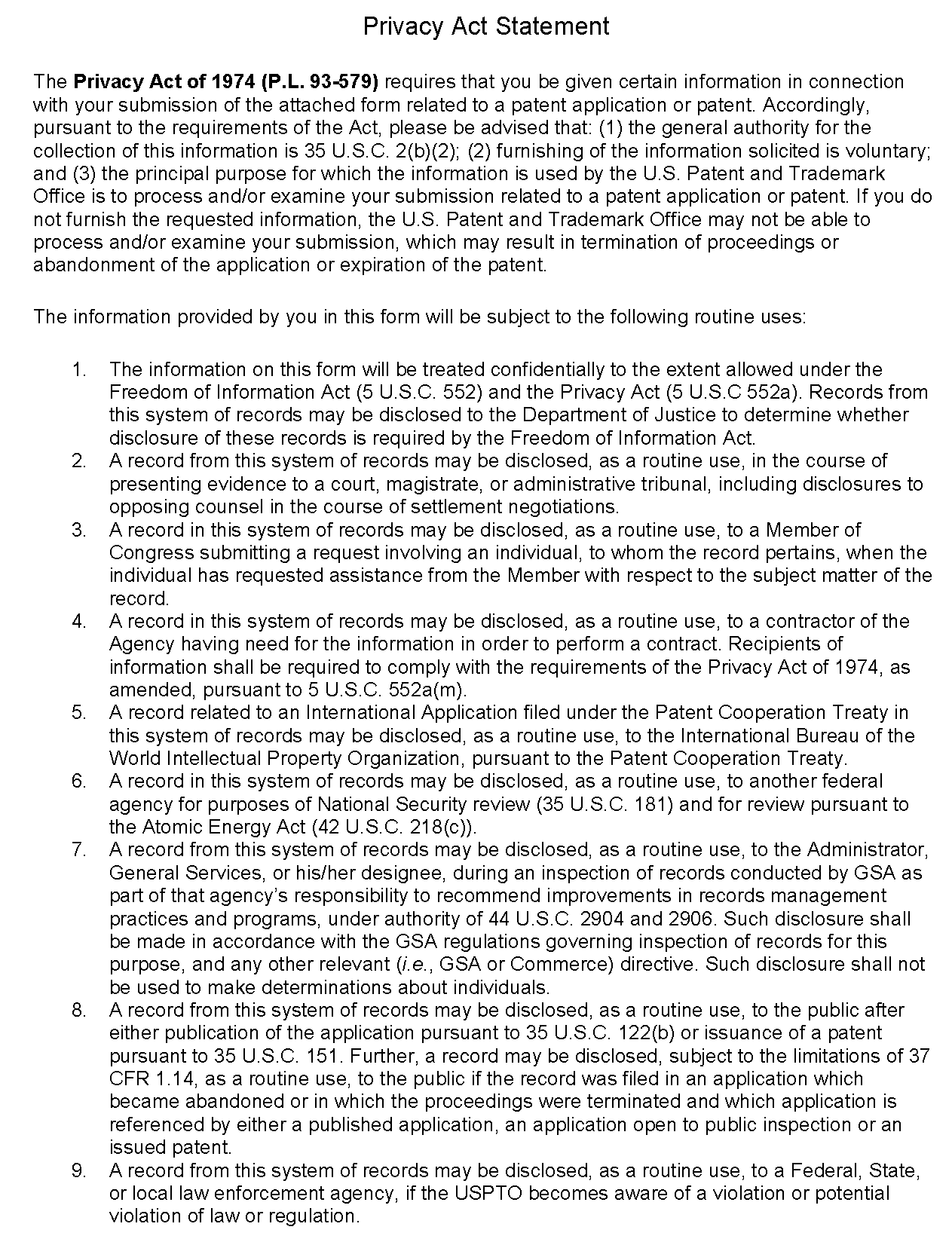Notice regarding Section 508 of the Workforce Investment Act of 1998. Section 508 of the Workforce Investment Act of 1998 requires all United States Federal Agencies with websites to make them accessible to individuals with disabilities. At this time, the MPEP files below do not meet all standards for web accessibility. Until changes can be made to make them fully accessible to individuals with disabilities, the USPTO is providing access assistance via telephone. MPEP Interim Accessibility Contact: 571-272-8813.
602 Original Oath or Declaration [R-7] - 600 Parts, Form, and Content of Application
602 Original Oath or Declaration [R-7]
35 U.S.C. 25 Declaration in lieu of oath.
(a) The Director may by rule prescribe that any document to be filed in the Patent and Trademark Office and which is required by any law, rule, or other regulation to be under oath may be subscribed to by a written declaration in such form as the Director may prescribe, such declaration to be in lieu of the oath otherwise required.
(b) Whenever such written declaration is used, the document must warn the declarant that willful false statements and the like are punishable by fine or imprisonment, or both ( 18 U.S.C. 1001).
35 U.S.C. 26 Effect of defective execution.
Any document to be filed in the Patent and Trademark Office and which is required by any law, rule, or other regulation to be executed in a specified manner may be provisionally accepted by the Director despite a defective execution, provided a properly executed document is submitted within such time as may be prescribed.
35 U.S.C. 115 Oath of applicant.
The applicant shall make oath that he believes himself to be the original and first inventor of the process, machine, manufacture, or composition of matter, or improvement thereof, for which he solicits a patent; and shall state of what country he is a citizen. Such oath may be made before any person within the United States authorized by law to administer oaths, or, when made in a foreign country, before any diplomatic or consular officer of the United States authorized to administer oaths, or before any officer having an official seal and authorized to administer oaths in the foreign country in which the applicant may be, whose authority is proved by certificate of a diplomatic or consular officer of the United States, or apostille of an official designated by a foreign country which, by treaty or convention, accords like effect to apostilles of designated officials in the United States. Such oath is valid if it complies with the laws of the state or country where made. When the application is made as provided in this title by a person other than the inventor, the oath may be so varied in form that it can be made by him. For purposes of this section, a consular officer shall include any United States citizen serving overseas, authorized to perform notarial functions pursuant to section 1750 of the Revised Statutes, as amended (22 U.S.C. 4221).
37 CFR 1.63 Oath or declaration.
(a) An oath or declaration filed under § 1.51(b)(2) as a part of a nonprovisional application must:
(1) Be executed, i.e., signed, in accordance with either § 1.66 or § 1.68. There is no minimum age for a person to be qualified to sign, but the person must be competent to sign, i.e., understand the document that the person is signing;
(2) Identify each inventor by full name, including the family name, and at least one given name without abbreviation together with any other given name or initial;
(3) Identify the country of citizenship of each inventor; and
(4) State that the person making the oath or declaration believes the named inventor or inventors to be the original and first inventor or inventors of the subject matter which is claimed and for which a patent is sought.
(b) In addition to meeting the requirements of paragraph (a) of this section, the oath or declaration must also:
(1) Identify the application to which it is directed;
(2) State that the person making the oath or declaration has reviewed and understands the contents of the application, including the claims, as amended by any amendment specifically referred to in the oath or declaration; and
(3) State that the person making the oath or declaration acknowledges the duty to disclose to the Office all information known to the person to be material to patentability as defined in § 1.56.
(c) Unless such information is supplied on an application data sheet in accordance with § 1.76, the oath or declaration must also identify:
(1) The mailing address, and the residence if an inventor lives at a location which is different from where the inventor customarily receives mail, of each inventor; and
(2) Any foreign application for patent (or inventor's certificate) for which a claim for priority is made pursuant to § 1.55, and any foreign application having a filing date before that of the application on which priority is claimed, by specifying the application number, country, day, month, and year of its filing.
(d)
(1) A newly executed oath or declaration is not required under § 1.51(b)(2) and § 1.53(f) in a continuation or divisional application, provided that:
(i) The prior nonprovisional application contained an oath or declaration as prescribed by paragraphs (a) through (c) of this section;
(ii) The continuation or divisional application was filed by all or by fewer than all of the inventors named in the prior application;
(iii) The specification and drawings filed in the continuation or divisional application contain no matter that would have been new matter in the prior application; and
(iv) A copy of the executed oath or declaration filed in the prior application, showing the signature or an indication thereon that it was signed, is submitted for the continuation or divisional application.
(2) The copy of the executed oath or declaration submitted under this paragraph for a continuation or divisional application must be accompanied by a statement requesting the deletion of the name or names of the person or persons who are not inventors in the continuation or divisional application.
(3) Where the executed oath or declaration of which a copy is submitted for a continuation or divisional application was originally filed in a prior application accorded status under § 1.47, the copy of the executed oath or declaration for such prior application must be accompanied by:
(i) A copy of the decision granting a petition to accord § 1.47 status to the prior application, unless all inventors or legal representatives have filed an oath or declaration to join in an application accorded status under § 1.47 of which the continuation or divisional application claims a benefit under 35 U.S.C. 120, 121, or 365(c); and
(ii) If one or more inventor(s) or legal representative(s) who refused to join in the prior application or could not be found or reached has subsequently joined in the prior application or another application of which the continuation or divisional application claims a benefit under 35 U.S.C. 120, 121, or 365(c), a copy of the subsequently executed oath(s) or declaration(s) filed by the inventor or legal representative to join in the application.
(4) Where the power of attorney or correspondence address was changed during the prosecution of the prior application, the change in power of attorney or correspondence address must be identified in the continuation or divisional application. Otherwise, the Office may not recognize in the continuation or divisional application the change of power of attorney or correspondence address during the prosecution of the prior application.
(5) A newly executed oath or declaration must be filed in a continuation or divisional application naming an inventor not named in the prior application.
(e) A newly executed oath or declaration must be filed in any continuation-in-part application, which application may name all, more, or fewer than all of the inventors named in the prior application.
37 CFR 1.68 Declaration in lieu of oath.
Any document to be filed in the Patent and Trademark Office and which is required by any law, rule, or other regulation to be under oath may be subscribed to by a written declaration. Such declaration may be used in lieu of the oath otherwise required, if, and only if, the declarant is on the same document, warned that willful false statements and the like are punishable by fine or imprisonment, or both ( 18 U.S.C. 1001) and may jeopardize the validity of the application or any patent issuing thereon. The declarant must set forth in the body of the declaration that all statements made of the declarant"s own knowledge are true and that all statements made on information and belief are believed to be true.
18 U.S.C. 1001 Statements or entries generally.
Whoever, in any matter within the jurisdiction of any department or agency of the United States knowingly and willfully falsifies, conceals, or covers up by any trick, scheme, or device a material fact, or makes any false, fictitious or fraudulent statements or representations, or makes or uses any false writing or document knowing the same to contain any false, fictitious or fraudulent statement or entry, shall be fined not more than $10,000 or imprisoned not more than five years, or both.
A provisional application does not require an oath or declaration to be complete. See 37 CFR 1.51(c).
I. OATH
A seal is usually impressed on an oath. See 37 CFR 1.66, MPEP § 604 and § 604.01. Documents with seals cannot be adequately scanned for retention in an Image File Wrapper, and since the Office maintains patent applications in an image form, the Office strongly encourages the use of declarations rather than oaths. However, oaths executed in many states including Alabama, Louisiana, Maryland, Massachusetts, New Jersey, New York, Rhode Island, South Carolina, and Virginia need not be impressed with a seal. See MPEP § 604 for execution of an oath, and MPEP § 604.01 and § 604.02 for information regarding seals and venue.
II. STATUTORY DECLARATIONS
U.S. Patent and Trademark Office personnel are authorized to accept a statutory declaration under 28 U.S.C. 1746 filed in the U.S. Patent and Trademark Office in lieu of an "oath" or declaration under 35 U.S.C. 25 and 37 CFR 1.68, provided that the statutory declaration otherwise complies with the requirements of law.
Section 1746 of Title 28 of the United States Code provides:
Whenever, under any law of the United States or under any rule, regulation, order, or requirement made pursuant to law, any matter is required to be supported, evidenced, established, or proved by sworn declaration, verification, certificate, statement, oath or affidavit, in writing of the person making the same (other than a deposition, or an oath of office, or an oath required to be taken before a specified official other than notary public), such matter may, with like force and effect, be supported, evidenced, established, or proved by the unsworn declaration, certificate, verification, or statement, in writing of such person which is subscribed by him, as true under penalty of perjury, and dated, in substantially the following form:
[1] If executed without the United States:
"I declare (or certify, verify, or state) under penalty of perjury under the laws of the United States of America that the foregoing is true and correct. Executed on (date).
(Signature)."
[2] If executed within the United States its territories, possessions, or commonwealths:
"I declare (or certify, verify, or state) under penalty of perjury that the foregoing is true and correct. Executed on (date).
(Signature)."
A 37 CFR 1.68 declaration need not be ribboned to the other papers, even if signed in a country foreign to the United States. When a declaration is used, it is unnecessary to appear before any official in connection with the making of the declaration. It must, however, since it is an integral part of the application, be maintained together therewith.
By statute, 35 U.S.C. 25, the Director has been empowered to prescribe instances when a written declaration may be accepted in lieu of the oath for "any document to be filed in the Patent and Trademark Office."
The filing of a written declaration is acceptable in lieu of an original application oath that is informal.
The following form paragraphs may be used to notify applicant that the oath or declaration is defective because it was not properly executed.
¶ 6.05 Oath or Declaration Defective, HeadingThe oath or declaration is defective. A new oath or declaration in compliance with 37 CFR 1.67(a) identifying this application by application number and filing date is required. See MPEP §§ 602.01 and 602.02.
The oath or declaration is defective because:
Examiner Note:
1. One or more of the appropriate form paragraphs 6.05.01 to 6.05.20 must follow this paragraph.
2. If none of the form paragraphs apply, then an appropriate explanation of the defect should be given immediately following this paragraph.
¶ 6.05.01 Improper ExecutionIt was not executed in accordance with either 37 CFR 1.66 or 1.68.
Examiner Note:
This paragraph must be preceded by form paragraph 6.05.
¶ 6.05.17 Declaration Clause OmittedThe clause regarding "willful false statements ..." required by 37 CFR 1.68 has been omitted.
Examiner Note:
This paragraph must be preceded by form paragraph 6.05.
III. EARLIER FOREIGN APPLICATIONS
Oaths and declarations must make reference to any foreign application for patent (or inventor's certificate) for which priority is claimed and any foreign application filed prior to the filing date of an application on which priority is claimed, unless such information is included in an application data sheet. See 37 CFR 1.63(c)(2).
If all foreign applications have been filed within 12 months of the U.S. filing date, applicant is required only to recite the first such foreign application of which priority is claimed, and it should be clear that the foreign application referred to is the first filed foreign application. The applicant is required to recite all foreign applications filed prior to the application on which priority is claimed. It is required to give the foreign application number and name of the country or office in which filed, as well as the filing date of the first filed foreign application.
If the information regarding the foreign application has not been included in an application data sheet, or in an oath or declaration, form paragraphs 6.05 and 6.05.08 may be used to notify applicant that the oath or declaration is defective because the prior foreign application has not been identified.
¶ 6.05.08 Identification of Foreign Applications OmittedIt does not identify the foreign application for patent or inventor's certificate on which priority is claimed pursuant to 37 CFR 1.55, and any foreign application having a filing date before that of the application on which priority is claimed, by specifying the application number, country, day, month and year of its filing.
Examiner Note:
This paragraph must be preceded by form paragraph 6.05.
IV. SOLE OR JOINT DESIGNATION
37 CFR 1.63 no longer requires the oath or declaration to state that the inventor is a sole or joint inventor of the invention claimed.
When joint inventors execute separate oaths or declarations, each oath or declaration should make reference to the fact that the affiant is a joint inventor together with each of the other inventors indicating them by name. This may be done by stating that he or she does verily believe himself or herself to be the original, first and joint inventor together with "A" or "A & B, etc." as the facts may be.
V. NEW MATTER ISSUES
For applications filed on or after September 21, 2004, a preliminary amendment that is present on the filing date of the application is part of the original disclosure of the application. For applications filed before September 21, 2004, a preliminary amendment that is present on the filing date of the application is part of the original disclosure of the application if the preliminary amendment was referred to in the first executed oath or declaration under 37 CFR 1.63 filed in the application. See MPEP § 608.04(b) and § 714.01(e).
If a preliminary amendment is present on the filing date of an application, and the oath or declaration under 37 CFR 1.63 does not refer to the preliminary amendment, the normal operating procedure is to not screen the preliminary amendment to determine whether it contains subject matter not otherwise included in the specification or drawings of the application as filed (i.e., subject matter that is "new matter" relative to the specification and drawings of the application). As a result, it is applicant's obligation to review the preliminary amendment to ensure that it does not contain subject matter not otherwise included in the specification or drawings of the application as filed. If the preliminary amendment contains subject matter not otherwise included in the specification and drawings of the application, applicant must provide a supplemental oath or declaration under 37 CFR 1.67 referring to such preliminary amendment. The failure to submit a supplemental oath or declaration under 37 CFR 1.67 referring to a preliminary amendment that contains subject matter not otherwise included in the specification or drawings of the application as filed removes safeguards that are implied in the oath or declaration requirements that the inventor review and understand the contents of the application, and acknowledge the duty to disclose to the Office all information known to be material to patentability as defined in 37 CFR 1.56.
Applicants can avoid the need to file an oath or declaration referring to any preliminary amendment by incorporating any desired amendments into the text of the specification including a new set of claims when filing the application instead of filing a preliminary amendment, even where the application is a continuation or divisional application of a prior-filed application. Furthermore, applicants are strongly encouraged to avoid submitting any preliminary amendments so as to minimize the burden on the Office in processing preliminary amendments and reduce delays in processing the application.
During examination, if an examiner determines that a preliminary amendment that is present on the filing date of the application includes subject matter not otherwise supported by the originally filed specification and drawings, and the oath or declaration does not refer to the preliminary amendment, the examiner may require the applicant to file a supplemental oath or declaration under 37 CFR 1.67 referring to the preliminary amendment. In response to the requirement, applicant must submit (A) an oath or declaration that refers to the preliminary amendment, (B) an amendment that cancels the subject matter not supported by the originally filed specification and drawings, or (C) a request for reconsideration.
For applications filed prior to September 21, 2004, a preliminary amendment that is present on the filing date of an application may be considered a part of the original disclosure if it is referred to in a first filed oath or declaration in compliance with 37 CFR 1.63. If the preliminary amendment was not referred to in the oath or declaration, applicant will be required to submit a supplemental oath or declaration under 37 CFR 1.67 referring to both the application and the preliminary amendment filed with the original application. A surcharge under 37 CFR 1.16(f) will also be required unless it has been previously paid.
If an oath or declaration improperly refers to an amendment filed after the filing date of the application and containing new matter, a supplemental oath or declaration will be required pursuant to 37 CFR 1.67(b), deleting the reference to the amendment containing new matter. See also MPEP § 608.04. If the application papers are altered prior to the execution of the oath or declaration and the filing of the application, new matter is not a consideration since the alteration is considered as part of the original disclosure.
See MPEP § 602.05(a) where a continuation application under 37 CFR 1.53(b) is filed with a copy of a declaration from a prior application, but the continuation application is filed with a rewritten specification.
If a claim is presented for matter not originally claimed or embraced in the original statement of invention in the specification a supplemental oath or declaration is required, 37 CFR 1.67, MPEP § 603.
VI. IDENTIFICATION OF APPLICATION
37 CFR 1.63 requires that an oath or declaration identify the specification to which it is directed. The declaration form suggested by the Office includes spaces for filling in the names of the inventors, title of the invention, application number, filing date, and foreign priority application information. While this information should be provided, it is not essential that all of these spaces be completed in order to adequately identify the specification in compliance with 37 CFR 1.63(b)(1).
The following combination of information supplied in an oath or declaration filed on the application filing date with a specification are acceptable as minimums for identifying a specification and compliance with any one of the items below will be accepted as complying with the identification requirement of 37 CFR 1.63:
(A) name of inventor(s), and reference to an attached specification which is both attached to the oath or declaration at the time of execution and submitted with the oath or declaration on filing;
(B) name of inventor(s), and attorney docket number which was on the specification as filed; or
(C) name of inventor(s), and title of the invention which was on the specification as filed.
Filing dates are granted on applications filed without an oath or declaration in compliance with 37 CFR 1.63, the oath or declaration being filed later with a surcharge. The following combinations of information supplied in an oath or declaration filed after the filing date of the application are acceptable as minimums for identifying a specification and compliance with any one of the items below will be accepted as complying with the identification requirement of 37 CFR 1.63:
(A) application number (consisting of the series code and the serial number, e.g., 08/123,456);
(B) serial number and filing date;
(C) attorney docket number which was on the specification as filed;
(D) title of the invention which was on the specification as filed and reference to an attached specification which is both attached to the oath or declaration at the time of execution and submitted with the oath or declaration; or
(E) title of the invention which was on the specification as filed and accompanied by a cover letter accurately identifying the application for which it was intended by either the application number (consisting of the series code and the serial number, e.g., 08/123,456), or serial number and filing date. Absent any statement(s) to the contrary, it will be presumed that the application filed in the USPTO is the application which the inventor(s) executed by signing the oath or declaration.
Form paragraphs 6.05 and 6.05.20 may be used to notify applicant that the oath or declaration is defective because the specification has not been adequately identified.
¶ 6.05.20 Specification Not IdentifiedThe specification to which the oath or declaration is directed has not been adequately identified. See MPEP § 602.
Examiner Note:
This paragraph must be preceded by form paragraph 6.05.
Any specification that is filed attached to an oath or declaration on a date later than the application filing date will not be compared with the specification submitted on filing. Absent any statement(s) to the contrary, the "attached" specification will be presumed to be a copy of the specification and any amendments thereto, which were filed in the USPTO in order to obtain a filing date for the application.
Any variance from the above guidelines will only be considered upon the filing of a petition for waiver of the rules under 37 CFR 1.183 accompanied by a petition fee ( 37 CFR 1.17(f)).
Further an oath or declaration attached to a cover letter referencing an incorrect application may not become associated with the correct application and, therefore, could result in the abandonment of the correct application.
Supplemental oaths or declarations in accordance with 37 CFR 1.67 will be required in applications in which the oaths or declarations are not in compliance with the other requirements of 37 CFR 1.63 but contain sufficient information to identify the specifications to which they apply as detailed above.
See MPEP § 1896 for the identification requirements for a declaration filed in a U.S. national stage application filed under 35 U.S.C. 371.
VII. COPIES OF OATHS OR DECLARATIONS ARE ENCOURAGED
A copy, such as a photocopy or facsimile transmission, of an originally executed oath or declaration is encouraged to be filed (see MPEP § 502.01), especially since applications are maintained in electronic form, not paper. The original should be retained by applicant, or his or her representative as evidence of authenticity. If a question of authenticity arises, the U.S. Patent and Trademark Office may require submission of the original. See 37 CFR 1.4(d)(1)(ii).
Note
See MPEP § 602.03 for other defects in the oath or declaration.
**>